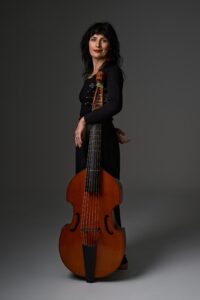 The viola da gamba (also called the “viol” or “gamba”) is a family of bowed string instruments. Just as the violin family has different-sized members (violin, viola, ‘cello) the viola da gamba comes in different sizes too, from treble (similar in size to a violin) through tenor and bass sizes to the biggest member, the violone. The violone is basically the only viola da gamba that survived past the end of the 18th century, evolving into today’s double bass. I play the bass viol, which is similar in size to a ‘cello, and it is the viol for which there is the largest solo repertoire, as well as being very useful as a bowed bass continuo instrument. While one might assume that the bass viol is some kind of ancestor of the ‘cello, they are in fact unrelated, with independent evolutionary paths.
The viola da gamba (also called the “viol” or “gamba”) is a family of bowed string instruments. Just as the violin family has different-sized members (violin, viola, ‘cello) the viola da gamba comes in different sizes too, from treble (similar in size to a violin) through tenor and bass sizes to the biggest member, the violone. The violone is basically the only viola da gamba that survived past the end of the 18th century, evolving into today’s double bass. I play the bass viol, which is similar in size to a ‘cello, and it is the viol for which there is the largest solo repertoire, as well as being very useful as a bowed bass continuo instrument. While one might assume that the bass viol is some kind of ancestor of the ‘cello, they are in fact unrelated, with independent evolutionary paths.
All members of the viola da gamba family are held either with the legs or (in the case of the treble) on the lap, hence its name; ‘viol of the leg’. Not super-poetic, but a good way to distinguish the family from the “viola da braccio” (‘viola of the arm’), or violin family. Violas da gamba have six or, in the case of big basses like mine, seven strings. The strings are all made of gut, and are tuned in intervals of 4ths with one 3rd, similar to the guitar family. The viola da gamba also has frets, which aren’t permanently set, like those of a guitar, but are instead made of gut (often just old strings) tied onto the neck which can be moved to accommodate different tuning temperaments. Very handy! The frets, as well as the relatively flat bridge and guitar-like tuning of the strings, means that chords work well on the instrument, and are often included with some complexity in solo repertoire.
Viols are bowed, but the bow is held differently – not overhand, as is a violin or ‘cello bow, but underhand with the fingers through the hair, a little bit like the modern German double-bass bow hold, although further away from the frog. This bowhold is very relaxed and natural, and works perfectly to bring out the viola da gamba’s subtle yet resonant sound and the voice-like qualities for which it was prized.
The viola da gamba has a long history, being popular throughout Europe from the 15th to 18th centuries, from about the time of Henry VIII of England (who played the viol himself) to that of Louis XIV of France. There are countless depictions of viols in Renaissance and Baroque art and there is a surprisingly large repertoire written specifically for the viol, either in consort, solo, solo with continuo, as obbligato parts in chamber music or used as a bowed bass continuo instrument. In France it was known as the ‘queen of instruments’, a reputation that I think is still well deserved now as ever.
Laura Vaughan